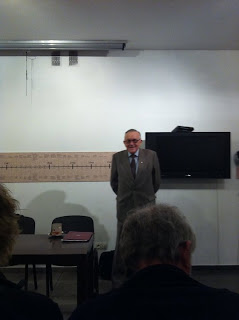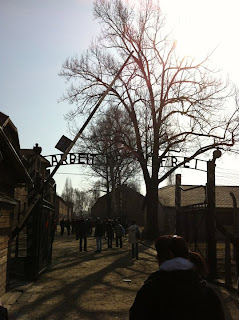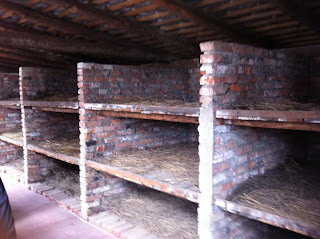I can’t believe this was only 70 years ago. It shocks me to the core how much the world
has moved on since Hitler tried to take it over with his own ideal breed of
humans.
To be honest I knew little if anything about Krakow, the
Jewish Ghettos or Oscar Schindler. I’d
never watched the film Schindlers List and I’d never heard of Auschwitz.
I’m not sure how to describe it, enjoyable is not the
correct word to use, although it is a magnificent city with hidden gems and
historic beauty, it also has its nasty secrets.
Leaving the airport on the train the place looked a bit
shabby and I noticed a lot of graffiti; getting off in the centre it still felt
rather derelict.
We walked through a precession of what I’d call market arcades,
predominantly food stalls lined with pastries and pizza slices.
As we wandered we found what you would expect in any town, a
square with what I assume was the town hall, a statue or two and a few shops,
bars and cafes.
We discovered a little park of some sort with benches and my
memory fails me but I will say a church and some other little quaint buildings
where we sat and enjoyed our pastries.
It was a nice start to the trip.
We then managed to stumble on our hotel the Wyspianski. For the money we paid I was made up with our
room. The trip had been arranged by our
house mate who works at a travel company and we got an amazing deal and a
wonderful bunch of people to boot.
The guide introduced himself and offered to go for a quick
walk locally, we declined and decided to explore things ourselves at our
leisure. After a couple of beers we
walked just a few minutes and found we were in another part of the city, the
more upmarket slick end. There were
streets lined with fascinating cocktail bars, enticing restaurants and novelty
type shops then we reached the main square Rynek Główny. The place looked newly built, there was
plenty of Alfresco dining and the main feature was a stunning architecture
designed with arches called ‘the Cloth Hall’ and was home to many Polish stalls
selling everything from scarves to tobacco pipes, an ideal place for
gifts.
Trust us to choose the most English looking ‘pub’ we could
find. My partner and I had one or two
and then we left the lads to it.
Refreshed and excited for our first night of Polish allure
we were served a three course meal at our hotel as part of the deal; I remember
an absolutely delicious soup we were all very impressed with. The main meal we all did a bit of a guess
work, I would have said they were turkey steaks topped with cheese and covered
in fried breadcrumbs. The kind of oven
food you can get from Tesco for about £2.00 served with chips and cabbage, it
was pleasant enough.
After getting to know some of the others we headed back over
to the square. It looked even more
spectacular in the evening, you could see into the restaurants and the Cloth
Hall was lit up beautifully. We sat
outside then the lads led us to a Polish bar they had found earlier of which
isn’t very helpful as I don’t recall the name, I do however recall the
hospitality of the poles. We made
friends with a big Polish dude and this may not be appropriate to say but I
find they have kind of a scary look about them, like they would have no problem
in slitting your throat then sitting down to a hearty Polish stew and
brew.
After some free ‘cinnamon graham’ shots from the nice Polish
man who refrained from harming us, we decided to leave the others and get off
to bed, long day ahead.
The Jewish Ghetto /
Schindler factory
Surprisingly the weather was warm, bright and sunny. We all gathered together to meet the guide
and set off towards the Jewish Ghetto.
After a short tram ride he showed us around the area with brief stops to
explain some of the terror stories that occurred during World War II, although
they weren’t stories.
Young and old families including children were forced from
their homes. The Jewish were rounded up and kept in an area with a massive high
wall where they could not get out. The
town was taken over by Germans and used as the government centre.
There is still a small community here; we visited the
markets and the High Synagogue. The
guide stopped us several times, he did a fantastic job explaining things and
keeping us interested.
Next up was Schindler’s factory. After a long walk most of us crashed on the
pavements whilst the guide did a pre talk.
At this point I wished I had worn comfier shoes.
I’m sure you know the story here so I won’t waffle too
much. Oscar Schindler had gotten a group
of Jews to work for him partly for cheap labour and partly to save their lives. I watched the Steven Speilberg movie and was
pretty moved by it. Having been and
having some and I say some because you can’t mentally take in what actually
happened, understanding it was interesting to watch and Liam Neeson portrayed
Oscar Schindler sensationally.
One last stop before home.
The Galicia Jewish
Museum
Everyone was struggling by now it had been a tiring day; it
was a photographic museum so we were shown round by the museum which ran
through a short description of sets of photos from throughout the War.
We were then to meet one of the survivors. He was a Polish gentlemen, perhaps in his 70s
or 80s; he had been a survivor of the
Warsaw death camp. He had an interpreter
who relayed his story to us and allowed us to ask questions.
I don’t think I have ever been so moved by another human
being before. He looked like the
sweetest old man. He told of how he was
captured as a young man and had lost his family in the camp. He conveyed information of horrendous living
conditions and how his weight plummeted to just bare bones. The jobs he and his fellow campers were made
to perform and the beatings that were regularly given by the Germans which
often resulted in death. You just could
not imagine the horror that these people suffered and to meet an actual person in
the flesh made it only too real.
After listening to the guide all day tell us and show us it
can never sink in to our brains as it is absolutely un-thought of and just incomprehensible
to people of our time. To see this man
come and share his life with us, I can tell you there were not so many dry
eyes. He had some photos of his time
there one of which was of a pile of human bodies mounded like rubbish bags
outside a takeaway, discarded like garbage.
It was heart breaking I really wanted to hug this man. He asked if we wanted to take pictures with
him and some did and shook his hand but I felt like he was a show and I just
felt a bit wrong.
It was a physically and mentally tough day.
My partner and I ended the night in a wonderful restaurant
close to our hotel with a typically Italian menu.
Auschwitz
Another bright and warm day, after a short coach ride we
arrived at Auschwitz 1.
If you don’t know what this is as I didn’t, Auschwitz is a
place 50km West of Krakow where the Germans transported the Jews and other
undesirables to. Auschwitz had their own
guide who was a lovely Polish girl. We
were given transmitting headsets so when the guide spoke into the mic we could
hear her regardless of all the other groups.
It surprised me how new the buildings looked, there were
many different blocks, it was a massive area. The guide explained that the Jews
were kept here as prisoners.
Jewish people of all ages and of all statures, Drs,
Professors, Bankers were taken from their
homes and transported to
Auschwitz. They were completely
oblivious to what was happening and to the purpose of Auschwitz. Some were put on trains with no clue what
their fate would be. There was little
food or water if any at all on these trains.
Those that were sick or elderly often didn’t even make it to Auschwitz. There were no facilities for using the
bathroom so there was also a spread of disease amongst the tightly packed
bodies that if they knew would have probably wished for their peril on that
very train.
The general feeling on the train was that they would be fed
and watered when they arrived at their destination.
The guide took us outside, the entrance way had a German
sign that read Arbeit macht frei which ironically means ‘Work makes you free’.
The guide described what kind of people had been brought to
Auschwitz and how they were given different uniforms to wear so they could be
easily identified. The German prisoners (criminals)
were given uniforms with green triangles they were usually treated as ‘Capos’
which meant they were in charge of the other prisoners. Jews were given a uniform with a yellow
triangle over a red triangle signifying the Star of David and other
nationalities a black star, homosexuals pink and political prisoners, red.
I cannot remember the exact order of the day which block we
visited first so I will just recall the best I can.
When people arrived in Auschwitz a selection took place; the
SS guards made two simple queues, those who could work and those that
couldn’t. Small children and the
elderly were separated from their families.
It was unknown to all of those people that this moment would probably be
the last time they would see their loved ones.
They were told to give up all of their belongings which the
Germans cruelly ordered them to label so as to ‘get them back afterwards’. They were tricked and lied to, led to believe
they were simply being cleaned up, showered and they would at some point get
their suitcases back.
Entering one block the wall was lined with photographs of
the prisoners. They all bore the stripy
prison uniforms except for their symbols.
The Germans had shaved the heads of all of the prisoners. Most of them looked starved and in ill
health.
We saw the kind of living quarters these ‘prisoners’ were
given and although it didn’t look great you cannot imagine how much worse it
must have been, they had obviously had to clean the place and get rid of the
smell. I remember one part that was just
soil and hay and obviously at the time would have been shared by many. The guide told us this was often inches deep
in rain water.
One of the things that stuck with me was when we saw all of
the belongings that had been taken. There were thousands of suitcases, glasses,
shoes, children’s things, piles and piles of it. The Germans had no intention of giving their
belongings back, they did it to keep order and to minimise panic. They even took the gold out of their teeth
and they sent the hair that had been cut back to Germany to be used to wove
things. It was a sad sight to see that
these belongings were once an actual persons and a person who had no doubt
suffered and died and this was all that was now left of them.
Birkenau
A short drive away was the second camp.
Auschwitz 1 was where the prisoners worked and lived.
Birkenau was where the train arrived where the selections took place and the
gas chambers murdered millions of people.
As mentioned earlier the sleeping quarters were rife with disease. There were no beds just concrete blocks to sleep in bunker style, the bottom
part was often wet which would cause violence between inmates for the security
of higher ground; some of the Capo’s got their own rooms.
I have a picture below of the toilet facilities.
As you can see this
one part alone is enough of a hell in itself to the likes of us. Having to share a hole with a room of
strangers, a dirty disgusting hole that was unclean and smells and most people
suffered horrendous bowel problems due to dysentery.
Nothing was sacred it was every man for themselves; if you
put something down it wouldn’t be there when you got back. The clever inmates took all of their
belongings with them wherever they went.
When washing they would hold things between their legs and struggle to
wash. The living conditions were so
appalling that no one was equipped for the work, the temperature and the vile
situations they were put in. Men were forced to carry out long hard days of
labour for 14 hours a day in clogs or shoes that were the wrong size, they
didn’t have warm clothes, soap, tissues, they had what they could steal and you
can’t blame them. Every ounce of
humanity was taken from these people.
The train track as
you can see from the piccies is still intact.
At the end of the tracks were some chambers that had been knocked down
when the Germans had realised we were coming.
There is now a small memorial site alongside these chambers with
messages and people’s names.
The gas chamber itself, the one which was still standing
brought an over whelming feeling. You
cannot imagine what had gone on in this very place, you stand breathing in the almighty
cold air. One thing I did feel in there
was a massive temperature drop and if I were to believe in the supernatural you
could have imagined the angry souls swimming around your head as you felt cold
and pitiful.
The weekend was one
of my favourite breaks I cannot use the word enjoyable as it doesn’t feel right
but to explore and learn all the things I did has truly imprinted on me and I
hope for their sakes in a positive way.
Our last night was spent with the group watching a band and
drinking cocktails in the Lizard King.
It’s been over a year now since our visit and I still think
about what an amazing trip we had and it’s led me to learn more about the war
and all the people involved including the survivors. I can recommend the book Five Chimneys by
Olga Lengyel and I definitely recommend a visit to Krakow.

















No comments:
Post a Comment